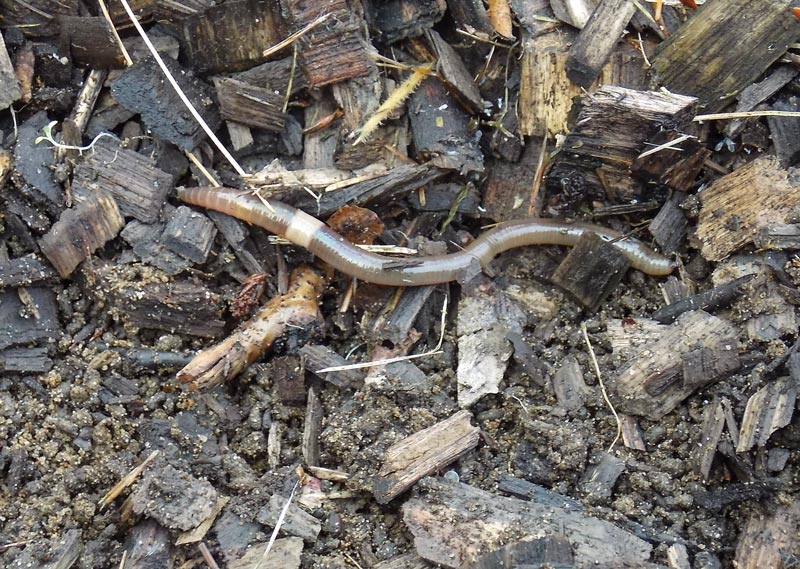
Jumping worms are similar in appearance to European earthworms, but they are dark brown to gray instead of reddish-brown, and the clitellum (collar) completely encircles the jumping worm’s body and is white and smooth, whereas other species have a raised clitellum. Photo courtesy of Josef Görres, University of Vermont
Jumping worm. Crazy snake worm. Asian jumping worm. Snake worm. Alabama jumper. Jersey wiggler. No matter what you call it, this invasive pest is beginning to have an impact in the United States.
Only a few earthworms are native to North America, and the most common worms in the U.S. are European earthworms. The origins of jumping worms in the U.S. are unclear, but they appear to have been delivered to the East Coast more than 50 years ago in a shipment of plants originating from Japan or Korea. Over time, the worm has proved to be aggressively invasive, fanning out from the northeastern states down the East Coast and through much of the Midwest and parts of the South. In 2016, jumping earthworms were reported in forests in Oregon.
Research published in 2016 revealed that the jumping worm is not a single species, as previously thought, but three closely related species: Amynthas agrestis, A. tokioensis and Metaphire hilgendorfi. The three species are generally found together, and it is rare to find only one species. All three species are parthenogenic — they reproduce asexually — which means that even a single cocoon or worm could establish an entire population. Their rapid breeding coupled with their voracious eating allows them to expand their habitat quickly.
Jumping worms are notable because of the damage they cause, which, in many cases, incurs a heavy economic cost to nurseries and forests (think maple syrup). They prefer managed landscapes like gardens and turfgrass, and they cause serious damage to forests, where they can very quickly strip organic matter from the forest floor, destroying habitat for numerous plants and animals.
Unlike European earthworms (also called nightcrawlers), which are generally considered beneficial by both farmers and gardeners, jumping worms do not burrow downward in the soil, and therefore do not create air spaces and encourage water drainage. Instead, they live on the soil surface and in the leaf litter, where they are easy to locate, and they quickly consume the upper layer of soil and organic matter, leaving behind pellets of dry soil that look like coffee grounds. Their activity degrades the soil, reduces its capacity to hold water, and prevents seedlings and wildflowers from taking root.
Golf courses have also been plagued by jumping worms. Dan Potter, Ph.D., and Carl Redmond, Ph.D., at the University of Kentucky had previously studied problems with European earthworm castings on golf courses when superintendents began contacting them concerning “prolific earthworm casting” on sand-based greens in summer. European earthworms generally present problems in late spring and early fall on fairways and push-up greens, so the researchers suspected something was amiss.
Sampling on the courses showed that the greens were infested with jumping worms, including Amynthas hupeiensis and A. loveridgei, which had not previously been connected with golf course damage. The jumping worms are active from May through September during the turfgrass growing season, and they produce castings day and night. This combination makes it difficult, at best, for crews to keep the greens playable, much less completely free of castings.
Given that no chemicals have been approved for control of jumping worms on golf courses or elsewhere, prevention is a priority. Jumping worms may have been introduced to some golf courses through riverbank sand brought in for renovations, so superintendents should be extra cautious when sourcing sand for any use on the golf course. Jumping-worm cocoons are inconspicuous (small dark dots) and travel easily in soil and compost, so again, sourcing materials is key. Workers should clean their shoes, clothing and equipment before entering a work site or leaving one work area and going to another.
A breakthrough of sorts occurred in May 2019, when research specialist Marie Johnston, Ph.D., and ecologist Brad Herrick, both at the University of Wisconsin-Madison Arboretum, published their research showing that heat can kill jumping-worm cocoons. The idea for the research came about because Wisconsin and many other states require commercial compost (which can be a carrier for cocoons) to be heated to 131 F (55 C) before it can be distributed. The researchers determined that treatments at 104 F (40 C) or higher should effectively kill the cocoons. The method is not foolproof, however, because compost could be contaminated after treatment, and heating may not be as successful outside the laboratory.
Johnston and Herrick and other researchers around the country will continue their quest to halt the progress of the destructive — and unusual — jumping worm.
Teresa Carson is GCM’s science editor.